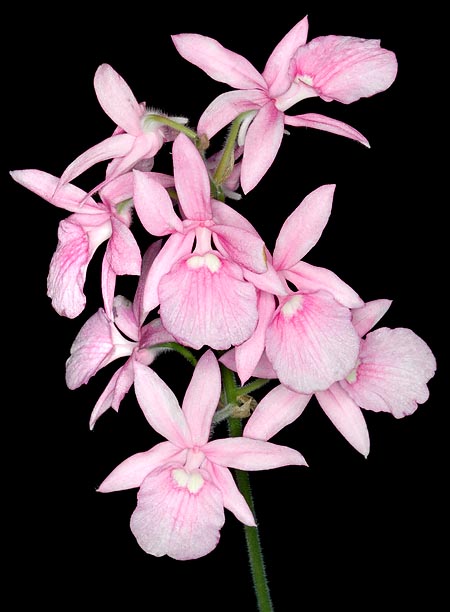Family : Orchidaceae

Text © Pietro Puccio

English translation by Mario Beltramini

Calanthe rosea flowering lasts even 2 months © Giuseppe Mazza
The name of the genus is the combination of the Greek terms “kalos” = beautiful and “anthos” = flower; the name of the species is the Latin term “rosea” = pinkish, with obvious reference.
Common names: pink calanthe (English); ueang chomphu phrai (Thai).
The Calanthe rosea (Lindl.) Benth. (1880) is a deciduous herbaceous species, terrestrial, cespitous, with fusiform, 6-8 cm, or more, long, pseudobulbs, with at the apex oblong leaves, plicate, up to about 30 cm long.
Racemose inflorescences in winter, after the fall of the leaves, from the base of the pseudobulb, pubescent, up to 40-70 cm long, carrying 10-30 flowers of 5-7 cm of diameter with similar sepals and petals of pink colour, and flat labellum, of more intense pink colour, and white throat. It reproduces by seed, in vitro, and, easily, by division, even of a single pseudobulb.
It is a vigorous species with a long lasting flowering, 1-2 months, which, in short time, if not divided, forms compact tufts.
In summer it requires a quite shaded position, medium-high temperatures, 30-32 °C at most, with humidity around the 60-80%, in winter it needs maximum luminosity, but not direct sun, with night temperatures of 15-18 °C, even if it can resist to exceptional, and for a very short time, lowering up to some degrees over the 0 °C.
Waterings must be frequent during the vegetative period, without ever letting dry the substratum completely, when the leaves begin to yellow, they are to be progressively reduced in order to dry up completely before giving water again, increasing the atmospheric humidity if the psedobulbs should wrinkle in an evident way; the waterings and the fertilizations are to be resumed gradually as soon as the new vegetation does appear.
For the waterings and the nebulisations are to be utilized either rainwater, or water obtained by reverse osmosis or demineralised one; the fertilizations, duly distributed, in such a way to avoid salts accumulations at the roots, are to be done preferably with hydrosoluble balanced products, with microelements, at half dosage in respect to that suggested on the package.
It is usually cultivated in pot with compost rich of organic substance with addition of agri-perlite or other inert around the 30% in order to improve the drainage; repotting and division, if necessary, are to be done by the end of the resting time.
Synonyms: Limatodis rosea Lindl. (1852); Alismorchis rosea (Benth.) Kuntze (1891); Alismorkis rosea (Lindl.) Kuntze (1891).
→ For general notions about ORCHIDACEAE please click here.
